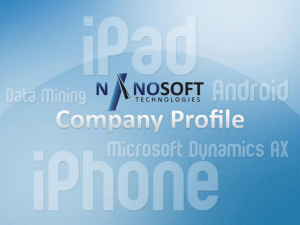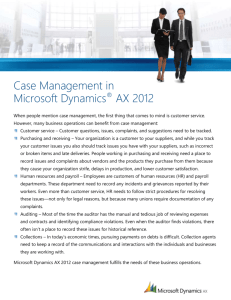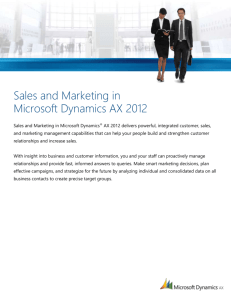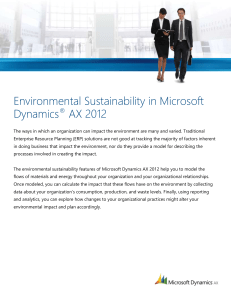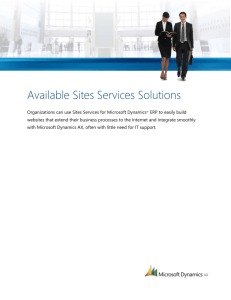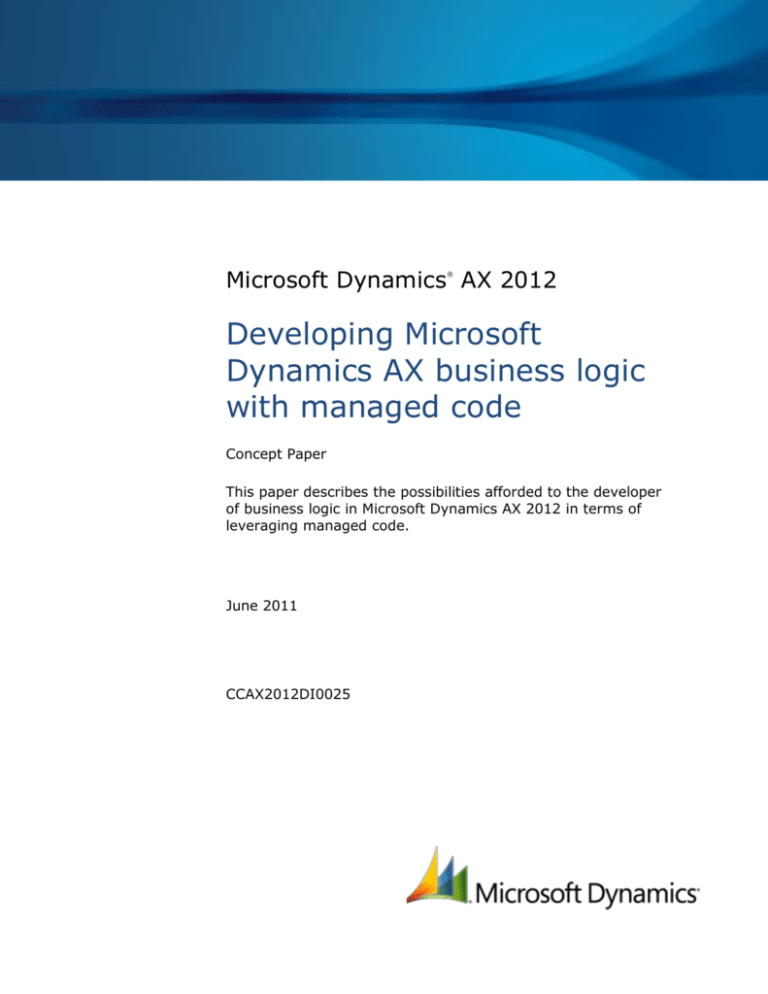
Microsoft Dynamics AX 2012
®
Developing Microsoft
Dynamics AX business logic
with managed code
Concept Paper
This paper describes the possibilities afforded to the developer
of business logic in Microsoft Dynamics AX 2012 in terms of
leveraging managed code.
June 2011
CCAX2012DI0025
Table of Contents
Overview..................................................................................................... 3
Using X++ ........................................................................................................................... 3
Using managed languages ..................................................................................................... 3
Using managed APIs from X++ ................................................................... 3
Writing business logic in managed code ..................................................... 4
Proxies ................................................................................................................................ 4
Runtime............................................................................................................................... 5
Using X++ as managed code ....................................................................... 5
Glossary of terms ........................................................................................ 6
2
DEVELOPING MICROSOFT DYNAMICS AX BUSINESS LOGIC WITH MANAGED CODE
Overview
The Microsoft Dynamics® AX environment features a rich palette of options for the business
application developer. The system is model-based and much can be achieved by describing the
expected functionality by editing metadata in the Application Object Tree (AOT). However, there will
always be a need to perform computation to provide the required functionality. This requirement can
be satisfied in two ways: by using the X++ language and by using managed languages.
Using X++
The Microsoft Dynamics AX Integrated Development Environment (IDE) features a rich environment
that was specifically designed to provide a Rapid Application Development (RAD) environment for
writing business applications. A pivotal part of this environment is the X++ language that was created
specifically to implement large scale ERP systems where efficient data manipulation is of paramount
importance. The X++ language is hosted within the MorphX IDE that contains everything needed for
successful development work: debugger, code profiler, tracing tools, and so on.
Using managed languages
In addition to the features provided by the X++ stack as just described, it is possible to author
business logic in either C# or Microsoft® Visual Basic® (VB).NET. As most C# and VB.NET developers
would expect, this development takes place in Microsoft Visual Studio® 2010, Microsoft’s premier
multipurpose extensible IDE. The Microsoft Dynamics AX tools are integrated with this environment,
allowing you to use all the features within that framework.
Using managed APIs from X++
The X++ language embraces managed objects as first class citizens. In other words, you can create
and use objects of managed types from within X++ code quite seamlessly. Syntactically, .NET types
are distinguished from X++ types by using the full name of the managed type, including the
namespaces. The lifetime of the objects is managed by the .NET garbage collector. You can use
managed APIs from assemblies that are added to the references node in the AOT, or you can author
the code in a managed project that is hosted within the AOT: In the latter case the C# or VB source
code and the project definition is available for editing directly from within the Microsoft Dynamics AX
IDE.
The following X++ code shows how a managed API can be used from X++:
public client static boolean copyFile(str fileName, str newFileName, boolean overwrite = false)
{
try
{
System.IO.File::Copy(fileName, newFileName, overwrite);
return true;
}
catch(Exception::CLRError)
{
return false;
}
}
3
DEVELOPING MICROSOFT DYNAMICS AX BUSINESS LOGIC WITH MANAGED CODE
Writing business logic in managed code
Using managed code from X++ as described above is certainly useful, but it is not the complete story.
It does not provide a compelling story for building interesting business logic in managed code: For
that you need a system that can seamlessly crisscross the boundaries between X++ and managed
code. Such a system is provided with Microsoft Dynamics AX and its integration with Visual Studio
2010. It is built with proxies and the Business Connector. To use this functionality, you must have
installed the Microsoft Dynamics AX Visual Studio tools.
Proxies
Managed developers are entitled to an editing experience where the X++ artifacts they interact with
appear as just another set of full fidelity managed objects, with the convenience of documentation
comments and full type safety. This richness is provided by using managed proxies to access the X++
code artifacts (classes, tables, and enumerations): The Microsoft Dynamics AX proxy concept is similar
to the proxy concept that Visual Studio provides for consuming web services: The consumer does not
see all the complex plumbing that takes place under the covers to make the interoperability happen,
either with the X++ objects or with the service implementation. The X++ proxies are more dynamic
than service proxies: Visual Studio will build the proxies anew every time a build takes place, so that
“stale” proxies never become an issue.
Proxies are used by selecting the artifacts that are required from the Application Explorer in Visual
Studio, and then simply dragging them to the solution that contains the managed application code.
This will build the managed proxies for the dragged artifact (and the artifacts that they depend on)
behind the scenes, so the proxies are ready to consume from the managed code. The illustration
below shows a Visual Studio solution using a few proxies.
4
DEVELOPING MICROSOFT DYNAMICS AX BUSINESS LOGIC WITH MANAGED CODE
If the solution is added to the AOT, then you will be able to deploy the assembly to the tier (that is,
either the client or the server) where it is executed. If the assembly is used on the client, the client
may have to be closed and restarted to use the new assembly.
Figure 1 Visual Studio project showing a few proxies
Runtime
When the client or server calls into the managed code, the context of the call is set up. This context
includes the user identity, the transactions running, and so on. This means that the managed code will
always run in exactly the same context as seen by the X++ code, creating parity between the runtime
environments.
As described previously, the proxies are managed representations of their X++ counterparts. Both
representations actually refer to the same instance: When the state of the object is changed on either
runtime environment, the change is reflected in the other runtime environment. This concept is
sometimes referred to as “object idempotency.”
Using X++ as managed code
In this scenario, the X++ code is compiled into managed code, and is therefore executed by the .NET
runtime system instead of the X++ runtime environment. This is currently done for code running
batch jobs and services on the Application Object Server (AOS), where the heavy lifting warrants
executing in managed code, where non-deterministic garbage collection is in effect.
5
DEVELOPING MICROSOFT DYNAMICS AX BUSINESS LOGIC WITH MANAGED CODE
Glossary of terms
Term
Definition
AOT (Application Explorer)
The application object tree where the model describing the application
can be viewed and modified.
C#
Pronounced “C sharp,” an object-oriented managed programming
language, used primarily by professional programmers.
VB.NET
A managed object-oriented programming language that can be viewed as
an evolution of the classic Visual Basic language (VB) which is
implemented on the .NET framework.
Visual Studio 2010
An integrated development environment (IDE) from Microsoft. It can be
used to develop applications in both native code and managed code.
Also, Microsoft ships tools that integrate with Microsoft Dynamics AX.
6
DEVELOPING MICROSOFT DYNAMICS AX BUSINESS LOGIC WITH MANAGED CODE
Microsoft Dynamics is a line of integrated, adaptable business management solutions that enables you and your
people to make business decisions with greater confidence. Microsoft Dynamics works like and with familiar
Microsoft software, automating and streamlining financial, customer relationship and supply chain processes in a
way that helps you drive business success.
U.S. and Canada Toll Free 1-888-477-7989
Worldwide +1-701-281-6500
www.microsoft.com/dynamics
This document is provided “as-is.” Information and views expressed in this document, including URL and other Internet Web site
references, may change without notice. You bear the risk of using it.
Some examples depicted herein are provided for illustration only and are fictitious. No real association or connection is intended or
should be inferred.
This document does not provide you with any legal rights to any intellectual property in any Microsoft product. You may copy and
use this document for your internal, reference purposes. You may modify this document for your internal, reference purposes.
© 2011 Microsoft Corporation. All rights reserved.
Microsoft, Microsoft Dynamics, the Microsoft Dynamics logo, Visual Basic, and Visual Studio are trademarks of the Microsoft group
of companies.
All other trademarks are property of their respective owners.
7
DEVELOPING MICROSOFT DYNAMICS AX BUSINESS LOGIC WITH MANAGED CODE



